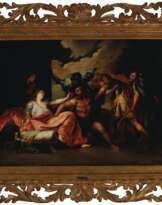ID 252199
Lot 1050 | Studie eines Christuskopfes
Valeur estimée
€ 80 000 – 120 000
Rückseitig auf der Tafel:
No: 530: / ANTON VON DEYCK.
Gutachten:
Prof. Christopher Brown, Oxford, nach Begutachtung des Originals in Köln am 13./14.Juni:
"Anthony van Dyck
Study for the Head of Christ
Paper (42 x 27 cm) pasted on a larger oak panel (52 x 38.5 cm) (These dimensions are taken from Barnes et al., cat. no. 1.19)
Inscribed in white paint, lower left, 25.
Provenance : Herzogliche Bilder-Galerie, Salzdahlum (the inventory number - 25 - painted on the lower left hand corner - appears to be a Salzdahlum inventory number. On the reverse is a painted inscription : No: 530: / ANTHON. VON DEYCK which also may refer to that collection, which was the founding collection of the Herzog Anton-Ulrich Museum in Braunschweig) ; Holland (not Hollandt, as in Barnes et al.) Collection, Braunschweig (according to Parthey) ; Fritz Beyer, Berlin, 1929-31.
Bibliography : For bibliography, see S. Barnes et al., Van Dyck. Complete catalogue of the Paintings, New Haven and London, 2004, cat. no. 1.19.
There can be no doubt that this is the painting illustrated and discussed at Cat. no. 1.19 in Barnes et al. (above). It is painted on paper and the paper has subsequently been trimmed in an irregular shape and then laid down on a larger panel. This was presumably done in the 17th century. The composition was then extended on both sides and at the bottom in order to create an independent work of art rather than a sketch. The additions were not by Van Dyck but by a later, 17th century, hand.
The panel is bevelled on the left edge and at the top and bottom but not on the right side. There are two (identical ?) seals in the top right and bottom left corners. There is also a curious compass mark, a circle with interlocking circles, on the back of the panel more or less in the centre of the panel.
It is difficult to be entirely definitive about the attribution or the state of the painting because of layers of heavy dark varnish. There are areas of damage in the face (especially on the viewer's left hand side) and substantial repainting (or strengthening) in, especially, the mouth, beard and hair. The clumsy highlight on the forehead and, perhaps, along the nose, were added or reinforced later. The photograph reproduced in Barnes et al. shows the painting in a slightly different state compared with its present appearance. Notably, the musculature of the neck is clearer. I suspect that the painting has been partially cleaned since the photograph was taken and the painting then revarnished. I studied the painting under excellent conditions in Cologne on June 13/14 2019.
Van Dyck painted relatively few oil sketches of individual heads or figures for his early works - the compositional sketches are drawings. However, in my opinion, this is (as far as can be judged in its present condition) an oil sketch for the Head of Christ in The Taking of Christ. This composition survives in three versions (Barnes et al., 1.17 [Corsham Court], 1.20 [Minneapolis Institute of Arts] and 1.21 [Prado, Madrid]) which Van Dyck painted in 1618-20. This oil sketch for Christ's head is closest in pose to the Corsham Court painting and so was presumably made as a preliminary study for that painting.
Professor Christopher Brown, University of Oxford."
Literatur:
- Beschreibung der Herzoglichen Bildergalerie zu Salzthalum, Braunschweig 1776, S.18, Nr.25;
- G.Parthey: Deutscher Bildersaal, 1863, Bd.I, S.378, Nr.65;
- Gustav Glück (Klassiker der Kunst), 1931, S.527, Nr.69-71;
- Horst Vey: Van Dyck-Studien, 1958, Ss.192, 206, Nr.39;
- Horst Vey, 1962, S.154;
- Barnes / de Poorter / Millar/ Vey: Van Dyck. A Complete Catalog, New Haven 2004 S.34, Nr. I.19.
Provenienz:
- Herzogliche Bildergalerie, Salzthalum, 1776;
- Sammlung Holland, Braunschweig 1843;
- Sammlung Hörstel, Braunschweig;
- Sammlung Fritz Beyer, Berlin, 1929-31;
- Privatsammlung Aachen, späte 1950er Jahre.
Ein Zertifikat des Artloss-Register zur Provenienz des Gemäldes liegt vor.
" Whereabouts unknown."
Das Werkverzeichnis zu den Gemälden Van Dycks konnte nur auf Abbildungen und überlieferte Beschreibungen der älteren Literatur zurückgreifen - der Aufenthaltsort unserer kleinen Studie ist beinahe einhundert Jahre unbekannt geblieben.
Um 1620, folglich etwa 21 Jahre alt, schuf Antons van Dyck drei Fassungen zu dem biblischen Thema "Die Gefangennahme Christie im Garten Gethsemane". Die jüngere Forschung ist sich einig, dass unsere Studie eine Vorarbeit zum Christuskopf für die im Bristol Museum and Art Gallery (ehemals Corsham Court) befindliche Variante ist.
Das Blatt zeigt sich heute unverändert in der Altmontierung des 17. Jahrhundert. und mit den unversehrten Inventarbezeichnungen des Herzog Anton Ulrich bzw. der daraus hervorgegangenen Museumssammlung von Braunschweig.
Wir danken Christopher Brown, Oxford, und Fred G. Meijer, Amsterdam, für ihre freundliche Unterstützung.
| Artiste: | Antoine van Dyck (1599 - 1641) |
|---|---|
| Catégorie maison de vente aux enchères: | Peintures des maîtres anciens |
| Artiste: | Antoine van Dyck (1599 - 1641) |
|---|---|
| Catégorie maison de vente aux enchères: | Peintures des maîtres anciens |
| Adresse de l'enchère |
VAN HAM Kunstauktionen GmbH Hitzelerstr. 2 50968 Köln Allemagne | ||||||||||||||
|---|---|---|---|---|---|---|---|---|---|---|---|---|---|---|---|
| Aperçu |
| ||||||||||||||
| Téléphone | +49 221 92586215 | ||||||||||||||
| Fax | +49 221 92 58 62 4 | ||||||||||||||
| Commission | 32% | ||||||||||||||
| Conditions d'utilisation | Conditions d'utilisation | ||||||||||||||
| Heures d'ouverture | Heures d'ouverture
|
















